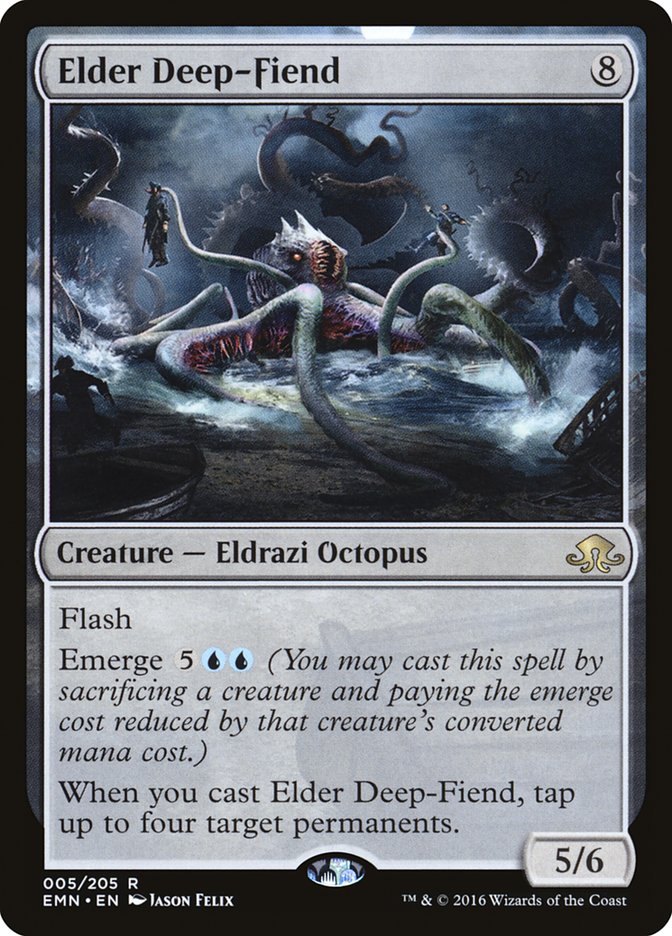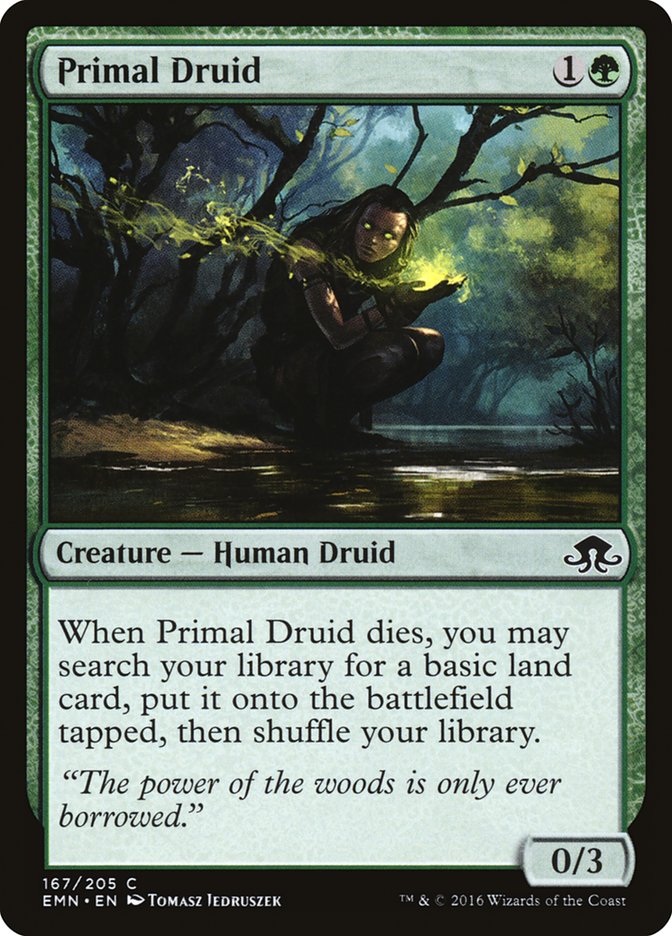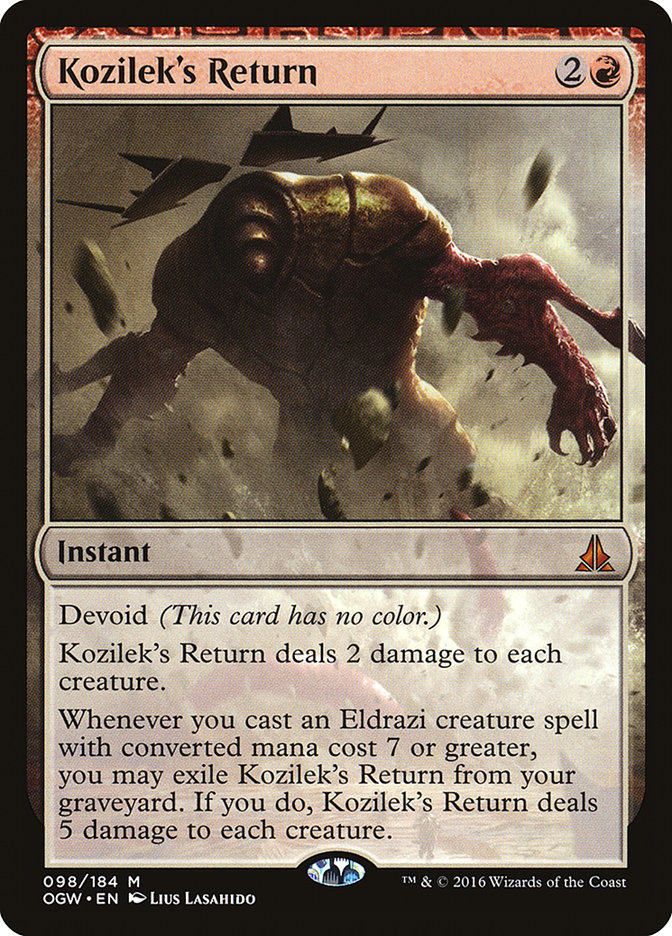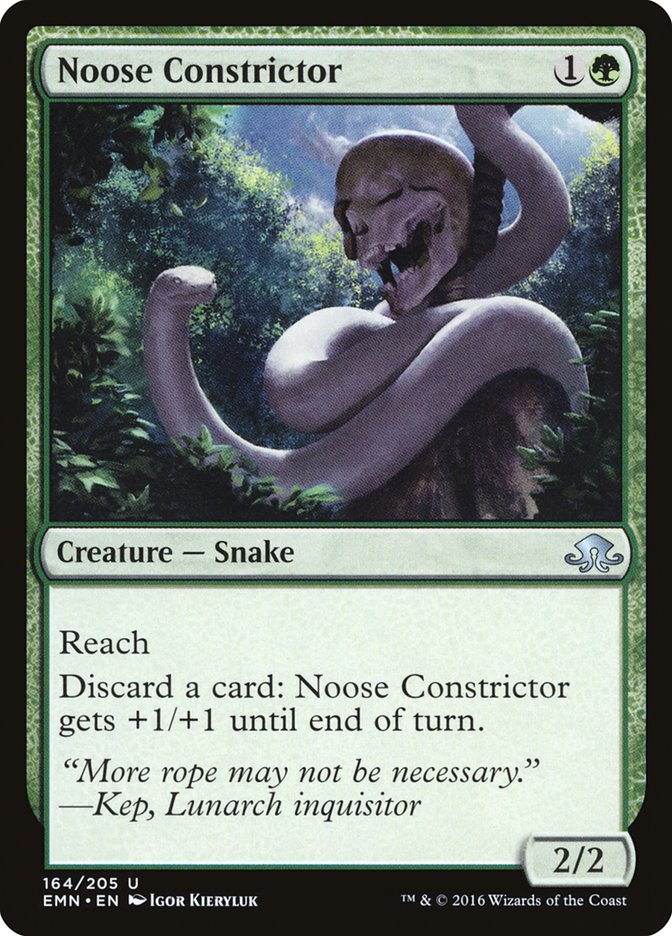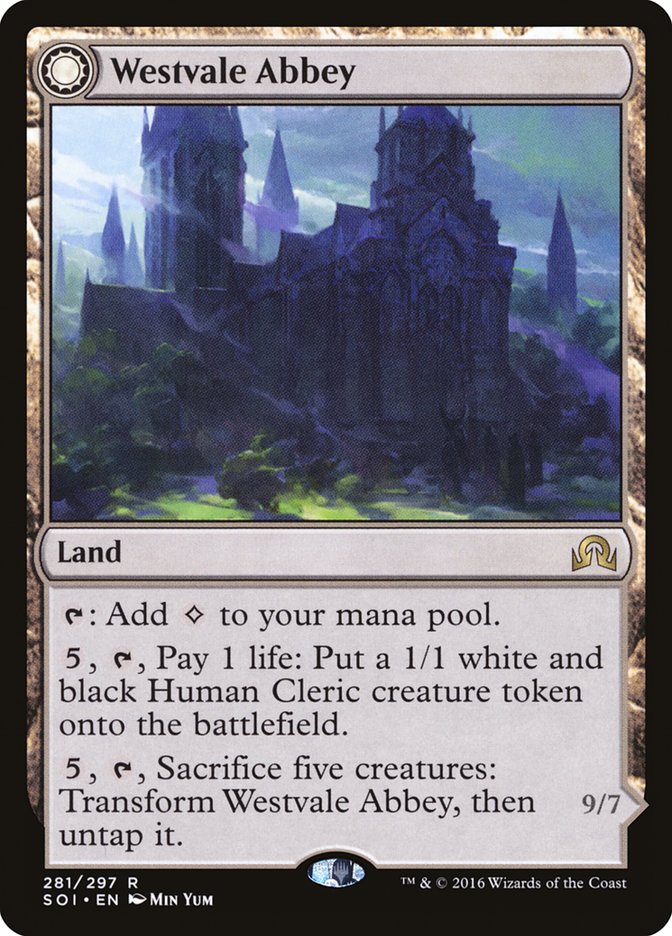This week I’ll try to tell you everything I know about Temur Emerge. Barring something exceptionally strange happening, it will be the deck I play at #SCGRICH and any other Standard tournament I happen to find myself playing between now and the release of Kaladesh.
In some respects, this is basically going to read as a guide on how to beat me over the next few weeks, but I’m okay with that. Temur Emerge is a ridiculously powerful deck and I’ve even called it broken. Does that mean that it is unbeatable? No, but I do think I’m generally a favorite against almost anyone but Bant Company, and even then the games are typically very close and require a lot of difficult decision-making on both sides.
I also hope to encourage some folks to start picking up the deck. It is certainly difficult to play, but simultaneously rewarding and extremely fun as well. You’re basically trying to solve a puzzle of how to get yourself into a position to do some of the most powerful things you could feasibly do in any Standard format. The games are incredibly dynamic, particularly so in the challenge of navigating Emrakul, the Promised End turns.
Temur Emerge is also a deck that largely will not rotate. It loses some role players, but none of its key pieces – naturally making it a fine starting point leading into the new Standard format. I suspect that it will in some form be a deck to beat in the first few weeks of Kaladesh and likely beyond the Pro Tour. Getting yourself acquainted with the archetype now is certainly not a wasted effort despite this season quickly fading away.
Anyway, let’s start with the maindeck. I think it’s more intuitive to introduce the sideboard later given how much I have to say about it.
Creatures (17)
- 3 Pilgrim's Eye
- 3 Emrakul, the Promised End
- 3 Wretched Gryff
- 2 Elder Deep-Fiend
- 2 Ishkanah, Grafwidow
- 4 Primal Druid
Lands (6)
Spells (37)

I hesitate to introduce the hyperbolic nature of the word “perfect,” but let’s just say that this is likely as good as I am capable of making the maindeck. My changes from the Invitational were basically to clean up the mana and tighten up the best elements of the deck all while essentially improving the threat density as well by going up to four Traverse the Ulvenwald. Traverse is one of the most powerful cards printed in recent memory and everyone is starting to figure out different ways to properly leverage it. Temur Emerge is yet another deck that is capable of maximizing its power.
In essence, the deck’s spells can be divided into various enablers, whether for emerge or delirium, and then a variety of different payoff cards with Emrakul, the Promised End sitting on top as the ultimate trump win condition.
Through various pieces and platforms I’ve touched on my logic for many of the changes (and merging if you will) I’ve made in regards to Owen’s original “combo Emrakul” deck from the Pro Tour, but to concisely put it all in one place:
This version of Temur Emerge is excellent at playing in every stage of the game. It doesn’t suffer from the linear nature of either Andrew or Owen’s deck by functioning as a great Kozilek’s Return deck that can get on the battlefield in a meaningful way early while simultaneously having the ultimate inevitability of Emrakul, the Promised End backed by Elder Deep-Fiend.
Primal Druid remains the most underrated Eldritch Moon card and shines brightly here as an effective way to build battlefield presence and buy time while simultaneously working Temur Emerge towards its various game plans all the while being resilient to removal. Primal Druid is the reason that the deck favors Wretched Gryff over Elder Deep-Fiend, as playing Gryff on turn 4 is so powerful for setting up Temur Emerge and building up a ton of resources while triggering Kozilek’s Return cheaply. As we will get to a bit later, Wretched Gryff is sideboarded out in basically every matchup that isn’t about speed, but it is important for making your deck cohesive and fast enough to contend with Bant Company.
How to Mulligan and Basics
As I touched on earlier, Temur Emerge is a deck divided into various enablers and payoffs. Achieving delirum is typically step one for getting off the ground, as Ishkanah, Grafwidow is so important in various matchups, and the faster that you can turn it on, the more comfortable you are by being able to draw powered-up Traverse the Ulvenwalds to buy time or find Emrakul, the Promised End. I talked last week about being mindful of using your enablers to maximize achieving delirium, but it largely boils down to paying attention, planning ahead, and being aware that not picking anything may very well be correct.
The importance of delirium is also a key component of your mulligan decisions. Generally speaking, keeping a hand without Vessel of Nascency, Gather the Pack, or Grapple with the Past is unacceptable. Of course, there are exceptions, with Nissa’s Pilgrimage and Kozilek’s Return having a lot of weight in these decisions.
Most “functional” hands are immediately turned on by one of the aforementioned ten cards and Temur Emerge is favored in many matchups that it isn’t under immediate pressure, so I will gladly keep hands that include a curve of Primal Druid and Nissa’s Pilgrimage or the means to cast a turn 3 or 4 Kozilek’s Return – particularly when paired with Wretched Gryff.
While I am typically happy keeping any hand that can play or crack Gather the Pack and Vessel of Nascency on turn 2, I’m more hesitant to keep Grapple with the Past and all air. Grapple doesn’t dig as hard as the aforementioned cards while also scaling greatly later in the game. There’s no shame in playing it early to set up when the rest of your hand is excellent, but it isn’t likely to get you there by itself.
This is as good a time as any to reiterate that unless you’re under pressure to meet a specific goal in the game (basically not die), then holding Grapple with the Past is ideal. Grapple and Traverse are the most powerful cards in the deck later in the game for the options they give you and Grapple having access to a fully stocked graveyard is clearly better than burning it early if possible.
As a result, the basic sequence on your enablers is Vessel of Nascency, then Gather the Pack, then Grapple with the Past.
The Sideboard
To start with, here are the majority of cards I would consider playable for Temur Emerge’s sideboard:
Generally speaking, the red cards have underperformed. Radiant Flames is a fine hedge against specifically Humans if one were to expect them in large numbers, but the red cards are difficult to cast early the way the deck is currently built, and diluting your deck with reactive cards is typically poor.
Noose Constrictor was in my sideboard for the longest time as both a solid roadblock against traditional Bant Company (Selfless Spirit and Spell Queller) and an aggressive tool against U/R Burn. I’ve only played against Burn a handful of times on Magic Online while avoiding it completely in real life thus far. This seeming flash in the pan, alongside Brad’s revival of Bant Humans and Noose Constrictor’s largely ineffective sizing against it, means that I won’t be playing it in Richmond.
From there the major focus of your sideboard is two-fold – improve your aggressive matchups slightly and give yourself an effective plan against Infinite Obliteration and to a lesser extent opposing Emrakuls.
With that in mind, here’s what I would currently register as my sideboard:
The only card really in question for me is Westvale Abbey. I’m happy with my sideboard plans and still have a card left over. Westvale Abbey is potentially a high-impact option against Burn that only requires one slot.
Perhaps trying to survive until you can play an Ishkanah and Traverse for Westvale Abbey before finally transforming it is too ambitious, but it does give you an actual plan in the matchup at the price of just a single slot. The other options are Evolutionary Leap and Nissa, Vastwood Seer. I would lean towards the latter – Evolutionary Leap, despite being immensely powerful against black decks, is a bit of a liability should you get your turn taken by Emrakul.
Having a package of Explosive Vegetation and an Ulamog, the Ceaseless Hunger is a nice way to turbo-charge your deck in ramp mirrors while simultaneously diversifying your threat suite against Infinite Obliteration. I’ve been happy with what such a small number of slots accomplishes.
Guide and Matchups
Bant Company
In:
Out:
Bant Humans
In:
Out:
The presence of various flying threats is what dictates which supporting creature makes its way into your deck. For the longest time I was chopping Gather the Pack in this matchup, but I ultimately came to the conclusion that digging towards (and enabling) Ishkanah, Grafwidow was too important. Drawing a second Pilgrimage is close to dead as you rarely have the time to cast it.
This is by far your hardest (normal) matchup, and the pace of the game will largely be decided by your Bant opponent. If they are pushing the aggression and spending their resources quickly, then setting up a Kozilek’s Return as quickly as possible is a reasonable path. On the other hand, I’ve lost several games where I was too quick to use the only Kozilek’s Return in my graveyard when I wasn’t in immediate danger and my opponent had plenty left in reserve.
In a similar vein, if your opponent isn’t pushing aggressively, then it is likely worth it to try to set up the battlefield where you have an additional high-impact creature or a legion of Spiders before deploying Emrakul, the Promised End. Being able to kill multiple of your opponent’s creatures off her Mindslaver effect can often be critical.
It might sound silly, but for the most part, if your life total isn’t getting chunked every turn, then you aren’t incentivized to make a move. Emrakul is still more powerful than just about everything Bant Company is capable of doing, so just be patient if you’ve weathered the storm and try to set up a sequence of Emrakul, the Promised End plus Elder Deep-Fiend to wipe their battlefield and set up lethal.
Should your opponent get especially reactive post-sideboard with Day’s Undoing, Learn from the Past, or a stack of countermagic, it might be worth considering bringing in your own Clash of Wills, as your life total is less likely to be under pressure with their configuration.
B/G Delirium, Jund Delirium, Black Control with Kalitas
In:
Out:
This is how you will sideboard against Infinite Obliteration decks. Kozilek’s Return has the biggest variance here because Kalitas is a real concern and the Delirium decks tend to have incidental creatures. In some rare circumstances, like Shaheen Soorani’s Esper deck, you can choose to cut all of the Kozilek’s Returns.
For the most part, your deck will just be more powerful than your opponents. You can either blow past them with quick Emrakuls, Ulamog, or Elder Deep-Fiend chains, or else pace the game with countermagic and grindy elements like Jace and Den Protector. I would certainly like access to a Nissa, Vastwood Seer in these types of matchups, so that might be enough to choose to include her instead of the Westvale Abbey.
Ramp Mirrors
In:
Out:
This applies to Temur Emerge mirrors as well as U/G Crush or R/G Ramp.
The latter two are mostly about setting up Elder Deep-Fiend chaining, but the strict mirror is quite intricate.
Emrakul is obviously powerful, as it basically means that your emerge creatures will start spontaneously combusting, but for the most part someone tends to seize control with Elder Deep-Fiends and never lets go. Explosive Vegetation and Clash of Wills are good weapons for getting too much mana for Deep-Fiend to matter or keeping an opponent’s threat off the table, but choosing which key turn to start Deep-Fiending is really tricky, and setting up a multiple-turn sequence in advance with Traverse the Ulvenwald or a reserved Grapple is difficult. As much as it might appear like a traditional ramp shootout, this is probably one of the more enjoyable mirrors for this class of deck.
Boss Humans
In:
Out:
This is fairly straightforward. Set up, don’t die. Again, because the power level of your deck is so much higher than theirs, if you aren’t dying, there’s no reason to turn the corner and start becoming the aggressor. The more resources you can accumulate, the more likely you are to lock up the game through a second or third wave. Be careful of Repel the Abominable after sideboarding and pick your moments to Kozilek’s Return cautiously.
It might appear odd to bring in the third Deep-Fiend here, but “Time Walking” your Boss Humans opponent is far more likely to be exactly that than against Bant Company, which can still get on the battlefield at instant speed. In particular, locking your opponent down and eating an Incited Rabble is a great starting point for taking control of the game.
Prized Amalgam Decks
In:
Out:
The various multicolored Emerge decks and Zombie decks are basically more aggressive and less powerful versions of Temur Emerge that are also extremely susceptible to Kozilek’s Return. If you can avoid getting Elder Deep-Fiend locked, then your Emrakul end-game is superior. Preserving your life total early in the game is important towards this cause so that you don’t get killed by two Deep-Fiend hits.
U/R Burn
In:
Out:
The actual hardest matchup. It’s entirely possible that I’m underrating Kozilek’s Return here and that killing Thermo- Alchemist is sufficient. Of course, depending on your opponent’s build, they might be more creature-based, so stay flexible. That said, if I register Westvale Abbey, my intention is just to dump as much as I can on the battlefield as quickly as possible and set up Ormendahl, the Profane Prince – essentially racing my opponent. Again, this probably isn’t the most reliable strategy, but it’s a plan.
Odds are still fairly good I won’t register the Abbey, leaving this matchup in a place where your best plan is to assemble multiple Elder Deep-Fiends as quickly as possible and soft-lock them to death.
***
That’s basically all I’ve got. Playing the games and developing the deck to this point has been an extremely rewarding experience and I’d recommend that everyone give it a shot. You know what I’ll be playing at #SCGRICH.



